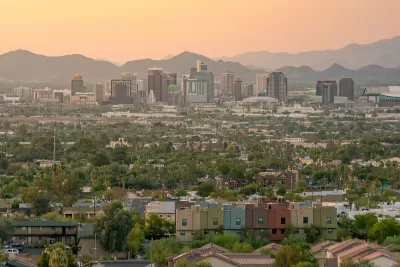In addition to lower citywide parking requirements on residential properties, a proposed law in Phoenix would lower minimum parking requirements even further for affordable housing developments near the city’s light rail system.

Phoenix planners are preparing a new law that would ease parking requirements for residential development around the city as well as transit oriented development near the city’s light rail system, with the Phoenix City Council expected to make a decision on the proposed zoning changes in September.
The proposed changes to the city’s parking requirements “would lower that bottom floor [set by minimum parking requirements] across the city but lower it even further for affordable housing complexes and developments in the Gateway, Eastlake-Garfield, Midtown, Uptown and Solano neighborhoods, which surround light rail,” according to a pawywalled article by Taylor Seely for the Arizona Republic.
“Under the new law, a 100-unit apartment complex in one of those five communities near light rail could see the requirement lower from 113 required spaces to 50 spaces. If it's an affordable complex in one of those communities, the parking quota would, in most cases, fall to zero,” adds Seely. “A 100-unit complex elsewhere in the city would go from 150 spaces to 125 spaces. If it's an affordable complex but not near light rail, it would go from 150 required spaces to 63.”
The source article notes that parking reform is increasingly popular in U.S. cities, listing Minneapolis, Portland, and Austin as examples.
The article lays out the arguments of supporters and opponents of the new law. Seely says residents “by and large” oppose the change, but implies that opponents might not be able to sway members of the Phoenix City Council from supporting the new law.
FULL STORY: Phoenix considers allowing fewer parking spaces for apartments in push for public transit [pawywall]

Alabama: Trump Terminates Settlements for Black Communities Harmed By Raw Sewage
Trump deemed the landmark civil rights agreement “illegal DEI and environmental justice policy.”

Planetizen Federal Action Tracker
A weekly monitor of how Trump’s orders and actions are impacting planners and planning in America.

The 120 Year Old Tiny Home Villages That Sheltered San Francisco’s Earthquake Refugees
More than a century ago, San Francisco mobilized to house thousands of residents displaced by the 1906 earthquake. Could their strategy offer a model for the present?

In Both Crashes and Crime, Public Transportation is Far Safer than Driving
Contrary to popular assumptions, public transportation has far lower crash and crime rates than automobile travel. For safer communities, improve and encourage transit travel.

Report: Zoning Reforms Should Complement Nashville’s Ambitious Transit Plan
Without reform, restrictive zoning codes will limit the impact of the city’s planned transit expansion and could exclude some of the residents who depend on transit the most.

Judge Orders Release of Frozen IRA, IIJA Funding
The decision is a victory for environmental groups who charged that freezing funds for critical infrastructure and disaster response programs caused “real and irreparable harm” to communities.
Urban Design for Planners 1: Software Tools
This six-course series explores essential urban design concepts using open source software and equips planners with the tools they need to participate fully in the urban design process.
Planning for Universal Design
Learn the tools for implementing Universal Design in planning regulations.
Clanton & Associates, Inc.
Jessamine County Fiscal Court
Institute for Housing and Urban Development Studies (IHS)
City of Grandview
Harvard GSD Executive Education
Toledo-Lucas County Plan Commissions
Salt Lake City
NYU Wagner Graduate School of Public Service





























